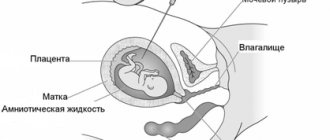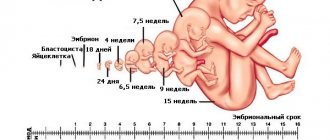Purpose of the study
The second prenatal (antenatal) screening is carried out after the 18th and before 21-22 weeks of pregnancy and allows you to identify serious disorders in the development of the fetus (pathologies), if any. The study includes only ultrasound diagnostics. The development of internal organs and anatomical structures is analyzed. Early diagnosis of pathologies allows you, together with your doctor, to choose the best tactics for further action. If necessary, more detailed studies are prescribed.
The meaning of the word "screening" can be translated as "selection", in the sense that women are selected who may require more thorough further examination.
Based on the screening results, it is important to follow the doctor’s recommendations. Some pronounced changes detected in the early stages disappear spontaneously, but require observation and control. You can also avoid the negative impact of some pathologies and provide your baby with a healthy life if you know about them and provide timely help.
Unlike the 1st, the 2nd screening of pregnant women also allows you to determine the sex of the baby and once again make sure that its size corresponds to the gestational age. The second indicator makes it possible to more accurately predict the approximate time of birth.
Ultrasound screening of the second trimester
At the second planned ultrasound, the specialist evaluates the progress of pregnancy and determines whether fetal development corresponds to normal parameters. The fact is that it is in the second trimester that signs of chromosomal abnormalities (severe developmental abnormalities) may first appear, and the doctor must be very careful not to miss them.
In the second trimester, at 20 weeks, the sex of the baby is usually determined. But sometimes expectant parents have to be patient to wait until the baby in the womb turns as it should.
List of examinations
Standard screening in the second trimester includes an ultrasound. Ultrasound diagnostics in the second trimester allows you to exclude or confirm many anomalies that are not related to the number of chromosomes. Among them: defects of the reduction type (absence of limbs), heart defects, disorders of the development of the kidneys and gastrointestinal tract, abnormalities of the spinal cord and brain. It is in the second trimester that all important functional organs and systems are formed, which makes it possible to identify such deviations.
Also, an ultrasound examination evaluates the placenta, its condition, place of attachment, volume of amniotic fluid, and the length of the cervix is measured. The last indicator (cervicometry) will show the doctor the likelihood of developing the risk of premature birth. These and other indicators are important in predicting the further course of pregnancy.
Prenatal screening: clarifying tests
A “bad” result from prenatal screening is not uncommon. In accordance with the FIGO Recommendations (2015)1, if the calculated risk of having a child with a chromosomal pathology is 1:100 or higher, the patient must be offered clarifying tests. Every time we get “bad” results, we worry along with the patient, but we try to explain that it is too early to cry. Clarifying tests most often make it possible to reliably prove that the baby is healthy.
“All the girls there were crying, I was the only one who was sure that everything would be okay!” — the pregnant woman tells me, proudly showing a piece of paper with the result 46XY. We will give birth to an excellent healthy boy without chromosomal pathology.
Yes, the likelihood that the child is completely healthy is very high. But if the fetus does have genetic abnormalities, you need to know about it in advance. Consultation in such cases is carried out by specialists in medical genetics, who can talk in detail about the results of clarifying testing and help parents decide whether to continue or terminate the pregnancy.
In fact, there are only two clarifying tests - invasive and non-invasive
. An invasive test is an intervention into the world around the fetus to obtain cellular material. Non-invasive - a study that is carried out on the mother's blood. Of course, donating blood from a vein after the 10th week of pregnancy is not at all scary, but it is very expensive and is not covered by the compulsory medical insurance fund. Both methods have their limitations, so it is worth considering them in more detail.
Invasive tests
Invasive tests are performed by highly qualified specialists. The purpose of the tests is to obtain fetal cells to study its chromosome set. At 10–13 weeks, a chorionic villus biopsy
. A special instrument is inserted through the cervix to pinch off small fragments of the placenta.
amniocentesis is performed at 15–20 weeks.
- under ultrasound control, a puncture is made with a thin needle and a small amount of amniotic fluid is collected.
Both procedures have their own risks and a 1-2% chance of miscarriage. That is why invasive tests are recommended only in cases where the likelihood of having a child with a chromosomal disorder is higher than 1–2%.
Cells obtained through invasive procedures can be examined in different ways:
- karyotyping
- the study is carried out within 2 weeks, the fetal chromosomes are arranged in a special order and make sure that there are no extra or damaged ones in the set; - The FISH method
is a quick way to exclude the most common anomalies in the 13th, 18th, 21st pair and anomalies of the sex chromosomes X and Y. If abnormalities are found, karyotyping is required; - advanced molecular genetic analysis
, which can detect microdeletions - small chromosome breaks that lead to serious diseases; - specific DNA tests for specific diseases
. For example, if healthy parents are carriers of the cystic fibrosis gene, they can each pass on a “sick” gene to their child, and the child will suffer from a serious illness.
NIPT - non-invasive prenatal testing
This is a completely new method that has been gradually entering clinical practice since 2011. Starting from the 9th–10th week of pregnancy, placental cells (trophoblasts) are isolated from the mother’s blood and their DNA is examined. This turned out to be enough to accurately diagnose the chromosomal pathology of the fetus in a very early stage of pregnancy (before the standard first screening).
The new method demonstrates excellent efficiency. According to researchers, out of 265 women with “poor” results of standard screening, only 9 patients will actually have a chromosomal pathology of the fetus identified2. If pathology is detected using NIPT, invasive methods will confirm the disease in 9 out of 10 fetuses3.
NIPT is a fairly expensive study. Highly accurate determination of the sex of a child is a very small free bonus of the method. Of course, the more parameters to be studied, the more expensive the analysis. A standard NIPT panel with an accuracy of 99% allows you to exclude Down syndrome, Edwards syndrome, Patau syndrome and sex chromosome abnormalities (this is a large group of diseases when instead of two sex chromosomes, one, three or even four are found).
The most expensive option is an extended study with microdeletions (small chromosome breaks), which makes it possible to exclude/confirm 22q11.2 deletion (DiGeorge syndrome), 1p36 deletion (Angelman syndrome, Prader-Willi syndrome, cat cry syndrome).
For example, 22q11.2 deletion of the fetus in young mothers is detected more often than Down syndrome4, and this pathology may not be immediately noticed even in newborns, and it is characterized by congenital heart defects, abnormalities in the structure of the palate, developmental delay, and schizophrenia at a young age.
Who should do NIPT?
You can find a huge number of indications for this test on the Internet. This includes the mother’s age 35+, habitual miscarriage, and cases of such children being born in the family. In fact, the only indication for NIPT is the woman’s desire
.
FIGO in 2015 proposed using the following diagnostic algorithm:
- at a risk of 1:100 or higher, carry out invasive diagnostics immediately, or first NIPT, then invasive diagnostics for those who have an abnormal result;
- at a risk from 1:101 to 1:2500, NIPT is recommended;
- if the risk is less than 1:2500, in-depth prenatal screening is not indicated.
It is much more important to understand in which cases the use of NIPT is impossible or inappropriate:
- history of blood transfusion;
- history of bone marrow transplant;
- maternal cancer;
- multiple pregnancy (three or more fetuses);
- twins in which one of the fetuses froze;
- donor egg/Surrogacy;
- the presence of ultrasound markers of chromosomal pathologies (in this case, NIPT is no longer needed).
In this case, it is very difficult to separate whose DNA is whose (the mother’s, one, or second, or third fetus, blood or tissue donor), so the results are uninformative.
Non-invasive tests have different brand names (Panorama, Prenetix, Harmony, Veracity) and differ slightly in the technique of execution. Each company carefully cherishes its “idea” and believes that its NIPT is much better than others.
What should you consider?
If your first screening reveals a high risk of chromosomal abnormalities, it is important to understand that risk is not a diagnosis. But if a woman is categorically against having a child with a chromosomal abnormality (it is important to understand that at the current stage of development of medicine such diseases are incurable), an invasive test is mandatory. It is possible to terminate a pregnancy after the 12th week only by decision of a medical commission with serious arguments in hand.
If a woman decides to carry the pregnancy to term in any case, she has the right to refuse further diagnostic procedures. At the same time, more specific information will help parents prepare for the birth of a “syndromic” child: find support groups on social networks, talk with parents raising such children, draw up a medical care plan in advance.
When it comes to choosing between invasive techniques and NIPT, it is important to understand that invasive test materials can be examined in different ways - and detect all sorts of diseases. And the NIPT technique answers only those questions formulated by the doctor. This is why invasive diagnostics still have the final word, although false-positive results occur with any type of testing.
Parents also have the right to completely refuse screening or any clarifying tests. In this case, it is sufficient to sign an informed voluntary refusal to intervene. However, if a woman changes her mind and still wants to undergo testing, some of them (those that are carried out strictly during certain periods of pregnancy) will no longer be possible.
Oksana Bogdashevskaya
Photo istockphoto.com
1. Best practice in maternal-fetal medicine. Figo Working Group On Best Practice in Maternal-Fetal Medicine // Int. J. Gynaecol. Obstet. 2015. Vol. 128. P. 80–82. [PMID: 25481030] 2. Norton ME, Wapner RJ Cell-free DNA analysis for noninvasive examination of trisomy // N Engl J Med. 2015. Dec 24; 373 (26): 2582. 3. Dar P., Curnow KJ, Gross SJ Clinical experience and follow-up with large scale single-nucleotide polymorphism-based noninvasive prenatal aneuploidy testing // Am J Obstet Gynecol. 2014 Nov; 211 (5): 527. 4. Combined prevalence using higher end of published ranges from Gross et al. // Prenatal Diagnosis. 2011; 39, 259-266.
The studied indicators and their norms
The screening ultrasound protocol in the second trimester of pregnancy consists of several parts:
- information about the patient;
- ultrasound fetometry (fetal parameters);
- assessment of the anatomical structure of the fetus and echographic markers of chromosomal abnormalities;
- description of the placenta, the number of umbilical cord vessels, signs of rotation (entanglement) of the umbilical cord and the amount of amniotic fluid;
- conclusion.
This time, ultrasound evaluates not only the size of the fetus, but also its position, condition and development of internal organs, bone structure (including the length of the tubular bones of the arms and legs; biparietal size - BPD - the distance between the tubercles of the parietal bones; frontal - occipital size - LZR - the distance between the most distant corners of the forehead and the back of the head), localization of the placenta, the amount of amniotic fluid and the place of attachment of the umbilical cord.
Violation of amniotic fluid norms can be observed due to the presence of genetic diseases or infectious diseases in the fetus. It can also negatively affect the development of the baby’s bone structure and nervous system. A fluctuation in the amniotic fluid index (AFI) is considered normal for 20 weeks of pregnancy - from 86 mm (lower limit) to 230 mm. The average normal value is 141 mm (for 20 weeks).
The placenta is inserted into the uterine cavity is analyzed. There is a risk of detachment if the placenta is attached to the lower part of the cavity. Another important indicator is the length of the cervix. Normally, at week 20 the length is slightly more than 40 mm. and the internal os of the cervix is closed (closed).
Extended fetometry is a mandatory component of the screening ultrasound protocol in the 2nd trimester of pregnancy. The data from fetometric measurements are compared by the doctor with standard values. Particular attention should be paid to patients whose fetometric data exceed the lower limit of standard values, which may indicate the presence of IUGR (intrauterine growth retardation).
Biochemical screening 2nd trimester
A blood test is not a mandatory component of the second perinatal screening. It is recommended that the expectant mother donate blood again if the results of the 1st trimester screening showed a risk of abnormalities. There are other situations when a pregnant woman is indicated for a biochemical blood test at 16-20 weeks:
- age 35+ in future parents or one of them - after 35 years, the quality of germ cells decreases, the likelihood of genetic mutations and congenital abnormalities in the fetus increases;
- history of miscarriages and frozen pregnancies;
- cases of birth of children with genetic disorders or Down syndrome in the family of one of the spouses;
As part of the blood test, the same indicators are analyzed as in the first trimester.
- Chronic human gonadotropin (hCG, often called the pregnancy hormone). Levels above normal may occur with Down syndrome or hydatidiform mole. Too low a concentration indicates a risk of miscarriage and Edwards syndrome.
- Alpha fetoprotein (AFP). A very low level of this protein produced by the fetal gastrointestinal tract can lead to Down and Edwards syndromes and fetal death. It also indicates an increased risk of miscarriage. Possible causes of increased concentrations are neural tube anomalies, Meckel's syndrome, and fetal esophageal atresia. On the other hand, it is caused by infectious diseases that the expectant mother suffered after conception.
- Free estriol. A decrease in the level of this female steroid hormone indicates the likelihood of hydrocephalus in the fetus, absence of the brain, Edwards, Down, Patau syndromes, and other disorders.
Features of preparation and timing
The study does not require any special preparation. You can eat, but three hours before the ultrasound it is not recommended to eat citrus fruits, seafood and carbonated drinks. The measurement results will be ready almost immediately after the examination. Literally within a few minutes after the diagnosis, you will be given a protocol with the data obtained. The study itself will take about half an hour. When examining in the second trimester, the data from the first prenatal screening from the 11th to the 14th week must be taken into account.
Back to list of articles
When do you need to take the Prenatal screening test in the 2nd trimester (14-20 weeks)?
1. Age over 35 years; 2. The presence of hereditary diseases in close relatives; 3. Down's disease or other chromosomal abnormalities of the fetus in previous pregnancies; 4. Exposure to radiation, harmful factors, or taking medications with a teratogenic effect by one of the spouses on the eve of conception; 5. with borderline results of the calculated risk of chromosomal pathology during screening of the first trimester, as well as if the screening examination of the first trimester was not carried out on time.








